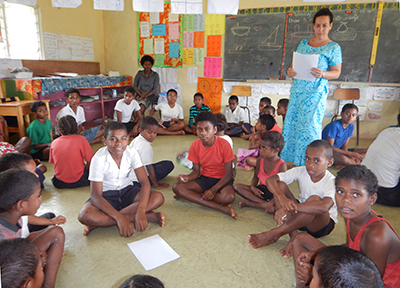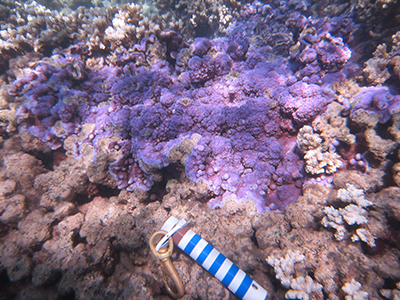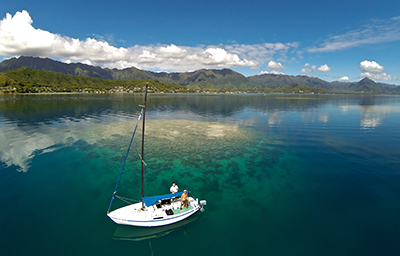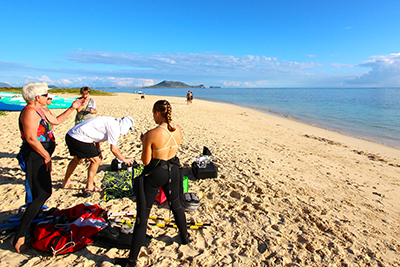About our research
Abstracts from our current ongoing projects
Investigating the Complexities of Coral Reef Social-Ecological Systems in Fiji
Efforts to build resilience to disturbance in human and natural systems have become of great focus in recent years as the world experiences increasing environmental, social, and economic change. Human and natural systems, however, are linked in complex ways and in order to enhance resilience in communities, a better understanding of the relationships in these social-ecological systems is necessary. Coastal communities in the Pacific are often characterized by a history of disturbance. There is evidence that the use of knowledge, practice, belief systems, evolved over millennia, have allowed Pacific Island communities to become resilient in overcoming natural disasters. However, it is uncertain how traditional ecological knowledge applies in a modern context. |
The Functional Role of Chromoproteins in Blue Montiporid Stony CoralsPutative photoprotective pigments may hinder blue corals under thermal bleaching conditions 
The blue rice coral, Montipora flabellata, is the fifth most abundant coral species in the main Hawaiian Islands and is presumed endemic but little else is known about it. The recent warmer-than- normal seawater temperatures in Kāne‘ohe Bay appeared to affect this species before others bleaching most blue colonies white. Their apparent hypersensitivity to thermal bleaching is possibly due to large concentrations of chromoproteins (CPs): the pigment-protein complexes responsible for the characteristic blue coloration and putative photoprotectors of the coral’s symbiotic algae Symbiodinium spp. This project is an in-depth investigation into the photobiology of M. flabellata with particular focus on the functional role of CPs since they are believed important for the coral’s survival in high light, high water-movement reef environments. Major goals for this three-year investigation include mapping and characterization of M. flabellata habitat in Kāne‘ohe Bay, identification and characterization of the blue pigments, locating CPs in coral epithelia via histology, and verification of the proposed role of CPs as Symbiodinium photoprotectants. Additionally, thermal bleaching experiments will allow us to better understand the benefits and potential pitfalls to CP possession and predict blue rice coral susceptibility to increases in seawater temperature. This project is led by Angela Richards Donà." |
The Effects of Ocean Warming on the Coral Communities of Ka'ohao (Lanikai)
Coral bleaching is a natural phenomenon that occurs as a result of stressful environmental factors including, but not limited to, increased sea temperatures and solar irradiance. An unprecedented bleaching event occurred in the Main and Northwestern Hawaiian Islands during Fall of 2014, in which Hawaiian corals reacted with differing levels of response, recovery, and mortality. This project began as a result of predictions from NOAA’s Coral Reef Watch program and aimed to document the extent of this event through monitoring and community participation in order to better understand bleaching susceptibility in corals at Ka'ohao (Lanikai), Oahu. In situ data loggers were used to measure seawater temperature from July-November 2014. Weekly surveys of 60 individual coral colonies recorded colony health over time at 6 sites using Coral Watch color reference scores and photographs. Surveys began in August 2014 and are ongoing. Temperature loggers and bi-monthly surveys will continue through 2015 in the event that there is another bleaching event and to document the patterns of recovery. Additionally, video transects were conducted during and after bleaching to measure extent of bleaching by species. Video transects will be recorded every two weeks throughout 2015 to further monitor coral recovery with time. During the 2014 event, bleaching affected (minimally to severely) over 90% of the corals at Ka'ohao, including Porites, Montipora, and Pocillopora spp. Visible bleaching at Ka'ohao differed by species, among and within colonies, and by location in the water column with no apparent trend related to any one variable. Recovery was variable in Porites, Montipora, and Pocillopora meandrina, but P. damicornis colonies exhibited complete mortality due to temperature stress. Further analyses will include examining genetic diversity among corals and symbionts in an attempt to reveal other explanations of such perplexing bleaching responses. This molecular work will utilize next generation sequencing to determine if there are differing levels of single nucleotide polymorphisms (SNPs) between bleached and unbleached samples in order to gain insight into any differences in bleaching susceptibilities found within species genotypic diversity. This project is led by Tayler Massey. |
Assessing Reef Condition in Response to Coastal Stressors Using a Low-Altitude Remote Sensing Platform
The global status of coral reefs is declining due to acute and chronic stressors that originate from natural and anthropogenic sources. Natural sources of stress such as sedimentation, increased nutrients and salinity flux have profound effects on reef health, while the frequency and intensity of these stressors can be exacerbated by anthropogenic manipulations of coastal systems through agriculture, river modification, and urban development. Although high levels of these stressors can cause mortality, lower levels can result in sub-lethal effects manifesting in increased instances of disease, altered growth, and reduced regeneration, reproduction, and recruitment rates, all of which can lead to ecosystem degradation and ultimately, regime shifts. To better understand the impacts of coastal stressors on reef condition, it is important to observe reef dynamics through a range of spatial and temporal scales. Current survey methodologies are time, money, and personnel-intensive, making consistent surveys of large reef areas unfeasible. Recent advances in remote sensing allow us to use unmanned aerial platforms as a low cost and highly efficient tool for collecting images, that can be processed using “structure from motion” techniques to produce high-resolution, geo-referenced images of large reef areas (~16,000m2). We plan to use this technology to image patch reefs in Kane'ohe Bay, and investigate how coral condition may change across a gradient of exposure to coastal stressors. UAV surveys can help highlight indicators of future severe coral stress and mortality such as pigment loss and macroalgal overgrowth, while providing managers with detailed spatial and temporal datum that demonstrate how reef communities respond to various environmental stressors in situ. This project is led by Joshua Levy. |
Spatial and temporal heterogeneity in spectral absorbance by intact coral-algal symbioses
More on this project coming soon |